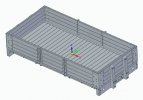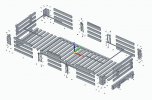ICH60
Western Thunderer
Hi
I have over the past few months been producing in Fusion360 an early 1 plank wooden under frame GWR wagon. My period is 1898 so I have a requirement for a few 1,2,3 and 4 plank wagons. This is a test to see what I can get out from my own 3D printing and to that end I final bought a Saturn2 8K printer.
The model is based on photographs ( there is not many) and information in various books, GWR Goods Wagons Atkins, Beard& Tourret and the Saltney Carriage and Wagon Works by T Wood mainly
The model was designed at full scale and then reduced to 7mm. The floor will be printed separately and fit inside the body. The idea is that the W irons, coupling hooks brakes will be etched, the buffers and axle box springs will be either printed or bought dependant on the state of repair over the years.
This was really a proof of concept rather than a final version. Still learning the best way to produce models in 360 there was a lot of 1 step forward two step back, and there will be changes from what I have learnt so far.
Render of the 3D model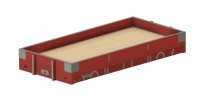
So last night I had a go at printing. Bit of a crash course in Chitubox, used the standard settings for the resin, I used Siraya Tech Fast, there were lots of extra supports and printed at 35um
I decided to print with the body parallel to the build plate as this was recommended by ianlbsc at the S7 Northern meeting.
So the first attempt failed at the start of the body after the supports. I forgot to take of the plastic protector of the build plate!!!!
Second attempt went well.
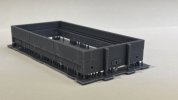
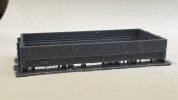
For some reason some of the supports seem to disappear. Not sure why?
Also there were lines on the bottom half of the model though very fine but not on the main body. Again not sure why?
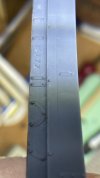
I have now cleaned up the model and I have sprayed the model in Halford Red Primer. This is what I think GWR wagon red was
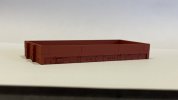
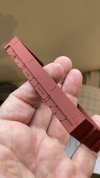
The bolt detail has come out well
I have to say that I am pleased with result. There are a few things to change on the next model one of which is a more defined gap between the different pieces of wood. I just used a fine chamfer on on edge.
I have over the past few months been producing in Fusion360 an early 1 plank wooden under frame GWR wagon. My period is 1898 so I have a requirement for a few 1,2,3 and 4 plank wagons. This is a test to see what I can get out from my own 3D printing and to that end I final bought a Saturn2 8K printer.
The model is based on photographs ( there is not many) and information in various books, GWR Goods Wagons Atkins, Beard& Tourret and the Saltney Carriage and Wagon Works by T Wood mainly
The model was designed at full scale and then reduced to 7mm. The floor will be printed separately and fit inside the body. The idea is that the W irons, coupling hooks brakes will be etched, the buffers and axle box springs will be either printed or bought dependant on the state of repair over the years.
This was really a proof of concept rather than a final version. Still learning the best way to produce models in 360 there was a lot of 1 step forward two step back, and there will be changes from what I have learnt so far.
Render of the 3D model

So last night I had a go at printing. Bit of a crash course in Chitubox, used the standard settings for the resin, I used Siraya Tech Fast, there were lots of extra supports and printed at 35um
I decided to print with the body parallel to the build plate as this was recommended by ianlbsc at the S7 Northern meeting.
So the first attempt failed at the start of the body after the supports. I forgot to take of the plastic protector of the build plate!!!!
Second attempt went well.


For some reason some of the supports seem to disappear. Not sure why?
Also there were lines on the bottom half of the model though very fine but not on the main body. Again not sure why?

I have now cleaned up the model and I have sprayed the model in Halford Red Primer. This is what I think GWR wagon red was


The bolt detail has come out well
I have to say that I am pleased with result. There are a few things to change on the next model one of which is a more defined gap between the different pieces of wood. I just used a fine chamfer on on edge.


